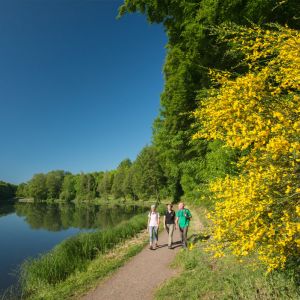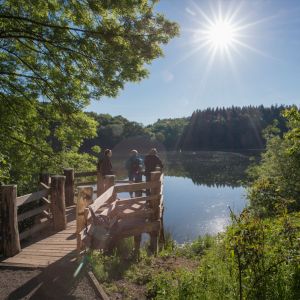Virtual tour, you can move through the image with the mouse.
Holzmaar Small - but powerful! Best researched in the world
The Holzmaar is the smallest, water-filled maar in the Eifel. Since the 1980s until today, science and research have shown great interest in the small maar. The University of Trier and the GeoResearch Center Potsdam have obtained and examined numerous drill cores from the lake sediments of the Holzmaar. The varves, i.e. the deposits on the maar floor, provide scientists with important information for researching the climate and regional settlement history.
New examination methods have been tested and optimized here. The sensors of the green buoy floating on the lake continuously measure the water parameters and algae density at different water depths. These are retrieved from the Jülich Nuclear Research Center via satellite for monthly evaluation.
Info
- Coordinates: 50°07'09"N / 06°52'04"E
- Altitude: 430 m above sea level
- Funnel diameter: 450 m x 300 m
- Funnel depth: 51-26 m
- Age: approx. 40,000 to 70,000 years
- Lake depth today: approx. 20 m
- Size of water area: 58,000 m2
Geology
In the basement there are Lower Devonian slates, sandstones and greywackes (Siegen stage/Herdorf layers), partly covered by maar tuffs.
Special features
Around 20,000 years ago, a volcanic triumvirate formed along a fissure in the earth's crust: Holzmaar, Dürres Maar and Hetsche Maar. Over time, the name Holzmaar became established for the youngest of the three maars, because the maar played a key role in securing the water supply to the nearby wood mill: the Maar basin served to absorb the artificially dammed water of the Sammetbach.
A toad fairy tale
A little further northwest there is a completely different landscape with the silted maar basin of the Dürren Maar. "Drought" refers to all maars that are no longer filled with water - i.e. dry. Today a rare, still growing raised bog covers the almost circular maar. The oldest of the three – the Hetsche Maar – has always been popularly known as “et Hetschemäärchen”. Why the maar became a “fairy tale” is obvious: with a diameter of only 60 meters, it is the smallest of all Eifel maars. The valuable wetland biotope is now home to toads and frogs. The local population also knew this and simply named the small maar after its inhabitants: “Hetsch” means “toad” in the local Platt.
Location
The Holzmaar is located approximately halfway between Gillenfeld (2.5 kilometers to the southwest) and Eckfeld in a nature reserve. It is almost completely surrounded by a natural beech forest.
Highlights nearby
- Dürres Maar
- Hetsche Maar
- Lavabombe Strohn
- Vulkano House Strohn
- Strohner Määrchen
- Pulvermaar
- Sangweiher
The Holzmaar is point 24 of the German Volcano Road.
Hiking trails around the Holzmaar
Whether you are interested in volcanism, dry maars, raised bogs or toad migrations - you are sure to discover new and beautiful things on the hiking tours around the Holzmaar.
Guided tours
Guided tours
Directions & Parking
The Holzmaar is located between Gillenfeld and Eckfeld at the intersection L16/K17. There is a hiking car park on K 17.




